After several lean years, more than 30 new drugs were approved in 2012 by the EMA. Dr Sarah Houlton looks at the new entries on the market.
After many years of low approval rates, in 2012 more than 30 new drugs were approved by the European Medicines Agency – nearing 40 if vaccines are included. However, in line with the trend for increasing numbers of ‘niche’ products being developed, few have the potential to become very big sellers.
That said, there are numerous new medicines with indications for diseases that affect large populations and where new and more effective treatments are very much needed – such as diabetes. With Type II diabetes reaching almost epidemic proportions in the developed world, where diets have become poorer and lifestyles more sedentary, there is a real need for new therapies that give better control of blood sugar levels. However, diabetes drugs are not cheap to develop – in the light of the serious side-effects seen with rosiglitazone (Avandia), regulators now expect ever larger trials to be carried out that will increase the possibility of safety signals being pinpointed before the drug reaches the market.
This has not stopped the pharma companies working in the area, though partnership to defray the huge costs is increasingly common. This was the case with dapagliflozin (Forxiga), where development was carried out by Bristol-Myers Squibb and AstraZeneca. The first-in-class medicine is a competitive, reversible, selective and orally active inhibitor of the human sodium-glucose co-transporter 2, or SGLT2. Its antidiabetic effect is a result of the reduction in the reabsorption of glucose in the kidney, with the glucose being excreted in the urine instead. Perhaps unsurprisingly, bearing in mind the Avandia debacle, the regulator demanded that a pharmacovigilance plan should be put in place.
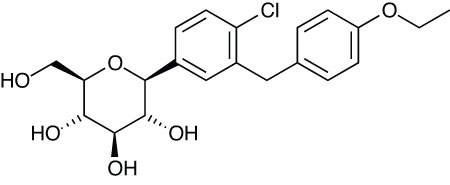
Dapagliflozin
Sanofi’s lixisenatide (Lyxumia) enters an already busy market. The glucagon-1 like peptide (GLP-1) analogue mimics the native hormone, and stimulates the release of insulin from the pancreatic islets. It also delays glucagon secretion, delays gastric emptying and reduces body weight. The injectable product is designed to be added to existing antidiabetic drugs or insulin to improve outcomes.
Two new versions of insulin itself were also approved, both from Novo Nordisk. Insulin degludec (Tresiba) binds to the human insulin receptor and has the same pharmacological effects as human insulin, but gives better glycaemic control, including a lower risk of nocturnal hypoglycaemia. Ryzodeg, meanwhile, is a combination of insulin degludec and insulin aspart, which is a fast-acting insulin. Again, it gives better glycaemic control.
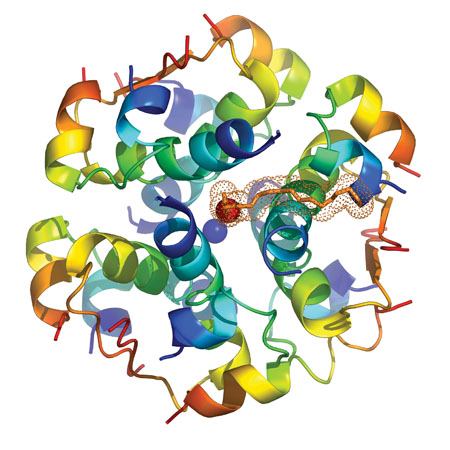
Degludec (Novo Nordisk, Tresiba) has the same pharmacological effects as human insulin, but gives better glycaemic control
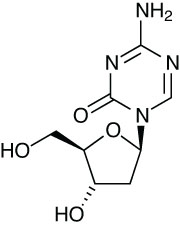
Decitabine
Unsurprisingly, the largest number of new medicines are designed to treat various forms of cancer. Some of these have real potential to make a big difference to patients’ outlook and are likely to gain further approvals in additional tumour types in future. Three of them are indicated for the treatment of blood cancers. Decitabine (Dacogen) from Janssen-Cilag is a cytosine nucleoside analogue that inhibits DNA methyltransferase, and has been shown to increase survival rates in patients with acute myeloid leukaemia.
CTI Life Sciences’ pixantrone (Pixuvri), an antineoplastic agent that inhibits topoisomerase II and DNA intercalation, was given conditional approval for non-Hodgkin B-cell lymphoma.
The approval remains conditional because more data are needed, but early indications are that
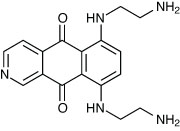
Pixantrone
the benefits outweigh the risks in this form of cancer in which there are no approved treatments for patients with aggressive, recurrent forms of the disease.
The third, brentuximab vedotin (Adcetris) from Takeda, is a monoclonal antibody drug conjugate for patients with relapsed or refractory CD30+ Hodgkin lymphoma. The antibody part of the drug, brentuximab, is specific for CD30+ expressing tumour cells, and delivers the highly potent antineoplastic agent monomethyl auristatin E, otherwise known as vedotin, to the cancerous cells.
On the solid tumour side, kinase inhibitors have provided a rich vein of drug targets, and several new drugs in this area have been approved. For example, crizotinib (Xalkori) from Pfizer selectively inhibits the anaplastic lymphoma kinase, or ALK, receptor tyrosine kinase, and its oncogenic variants. It also inhibits the hepatocyte growth factor receptor, otherwise known as c-Met, tyrosine kinase receptor. It has been approved for patients with previously treated ALK-positive advanced non-small cell lung cancer.
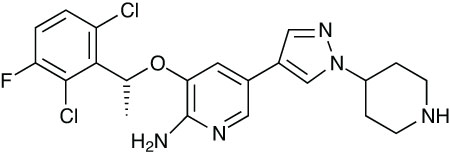
Crizotinib
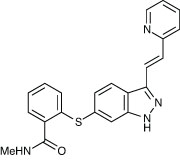
Axitinib
A second small molecule anticancer agent from Pfizer is another kinase-specific drug, axitinib (Inlyta). This is indicated for the treatment of pre-treated renal cell carcinoma, and is a protein kinase inhibitor of vascular endothelial growth factor receptors. It inhibits VEGF-mediated endothelial cell proliferation and survival.
A related drug, ruxolitinib (Jakavi) from Novartis, is a protein kinase inhibitor whose antineoplastic activity results from selective inhibition in Janus-associated kinases involved in signalling, and has been approved for the treatment of myelofibrosis. This condition results from the proliferation of abnormal bone marrow stem cells, which leads to the marrow being replaced by fibrous tissue.
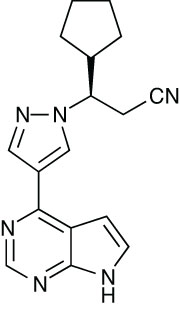
Ruxolitinib
It can be a primary condition, or result from another disease such as chronic myeloid leukaemia. The ability to create new blood cells in the bone marrow is impaired, and the spleen becomes enlarged. Ruxolitinib is able to reduce the size of the spleen by at least a third.
Two new biologic anticancer drugs were also approved. Roche’s pertuzumab (Perjeta) is a recombinant humanised monoclonal antibody that targets the extracellular dimerisation domain of the human epidermal growth factor receptor 2 protein, or HER2. This blocks the ligand-dependent heterodimerisation of HER2 with other members of this family of proteins, including EGFR, HER3 and HER4. It also inhibits ligand-initiated intracellular signalling through mitogen-activated protein, or MAP, kinase to give cell growth arrest, and phosphoinositide 3-kinase, or PI3K, leading to apoptosis. It is licensed for use in combination with trastuzumab and docetaxel in HER2 positive metastatic cancer patients who have not previously received anti-HER2 therapy.
The second, aflibercept (Zaltrap), marketed by Sanofi under licence from Regeneron, is a fusion protein that acts as a decoy receptor of VEGF, which interferes with the angiogenesis process. It is indicated for the treatment of patients with metastatic colorectal cancer that is either resistant to or has progressed on oxaliplatin, and should be given in combination with irinotecan, 5-fluorouracil and folinic acid.
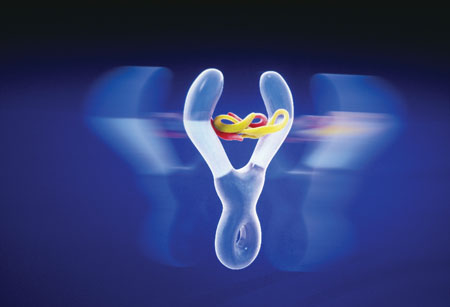
Aflibercept (Zaltrap), marketed by Sanofi under licence from Regeneron, is a fusion protein that acts as a decoy receptor of VEGF, which interferes with the angiogenesis process
The same fusion protein was also given the go-ahead for the treatment of wet age-related macular degeneration. Licensed by Bayer and sold under the name Eylea, it interferes with the progression of AMD by binding and inhibiting VEGF-A, and preventing neovascularisation.
There is a constant need for new antibiotics as bacteria become resistant to existing ones, and one such product was approved last year – ceftaroline fosamil (Zinforo) from AstraZeneca. It is a novel oxyimino cephalosporin that retains activity against methicillin-resistant Staphylococcus aureus, and has been licensed for the treatment of complicated skin and soft tissue infections, and also community-acquired pneumonia.

Ceftaroline
Another anti-infective was given the go-ahead – but only for use outside the EU. Shin Poong Pharmaceutical’s Pyramax is a fixed dose combination of the artemisinin derivative artesunate, and pyronaridine, an antimalarial that has been in use in China for more than three decades. The product, which was developed in collaboration with the Medicines for Malaria Venture, was given EU approval, despite not being indicated for use in Europe, because the committee’s scientific opinion can be used when applying for marketing authorisation elsewhere.
A true ‘first’ came in the form of UniQure Biopharma’s alipogene tiparvovec (Glybera). The first gene therapy to gain EU approval, it is designed to treate lipoprotein lipase deficiency in patients with severe or multiple pancreatitis attacks, despite dietary fat restrictions. This rare disorder affects maybe one or two people in a million, and the inability to produce sufficient of the fat-digesting enzyme is caused by a defective gene. The product uses an adeno-associated virus vector to add working copies of the LPL gene into muscle cells, enabling the production of the enzyme there.
Novo Nordisk’s catridecacog (Novothirteen) is another drug designed to treat a deficiency – in this case, patients with congenital factor XIII A-subunit deficiency. The product is a recombinant version of the coagulation factor, and when activated it cross-links fibrin and other proteins, improving clotting performance by giving the fibrin clot increased mechanical strength and resistance to fibrinolysis.
In contrast, Cushing’s disease involves too much of a hormone being made – adrenocorticotrophin – which in turn stimulates the adrenal glands to release an excess of cortisol into the blood. It results from a small tumour in the pituitary, and patients with the condition experience weight gain, high blood pressure and a weakening of the muscles and bones. For those patients that cannot be cured by surgery, there has been no approved treatment – until now. Pasireotide (Signifor) from Novartis is a somatostatin analogue, and is able to reduce or even normalise urinary free cortisol.
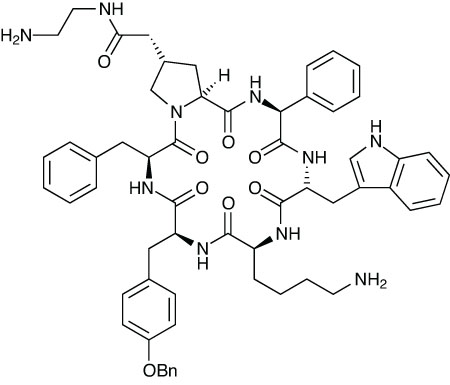
Pasireotide
Some patients with advanced chronic kidney disease undergoing dialysis develop hyperphosphataemia, and Mitsubishi Pharma’s colestilan (BindRen) is designed to lower the serum phosphorus concentration in these patients. It is not absorbed or metabolised in the GI tract; instead, it acts as a non-calcium, non-metallic phosphate binder.
Another problem patients with chronic kidney disease can experience is iron deficiency anaemia. Takeda’s ferumoxytol (Rienso) is an intravenous preparation of a colloidal iron–carbohydrate complex. When released from the complex, the iron will either enter the intracellular storage iron pool, for example as ferritin, or is transferred to plasma transferrin for transport to erythroid precursor cells ready for incorporation into haemoglobin.
Irritable bowel syndrome affects up to a fifth of the population in the Western world, yet it is very difficult to treat and produces a broad range of symptoms. Linaclotide (Constella) from Almirall is the first drug to be given European approval to treat IBS. It is licensed for the symptomatic treatment of patients with moderate to severe IBS with constipation. The synthetic 14-amino acid peptide increases the secretion of fluid in the intestine, thus accelerating the movement of material through the gut.
Short bowel syndrome is a much less common condition affecting the intestines. It results either from severe intestinal disease or the surgical removal of much of the small intestine, and because there is insufficient gut for enough nutrients to be absorbed as they pass through, most patients rely on parenteral nutrition, with all the problems that entails, such as the potential for infection, and impact on lifestyle. Nycomed’s teduglutide (Revestive) promotes repair and normal growth of the intestine that increases villus height and crypt depth, thus preserving mucosal integrity. It results in a reduction of the need for parenteral nutrition.
The incidence of chronic obstructive pulmonary disease is rising, as long-term smokers get older and their lungs are increasingly damaged by the habit. Two new products were approved to alleviate the symptoms. Glycopyrronium bromide (Enurev Breezhaler) from Novartis and Almirall’s aclidinium bromide (Bretaris Genuair) are both anticholinergic agents that inhibit bronchoconstriction induced by acetylcholine.
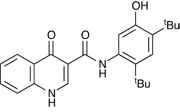
Ivacaftor
Cystic fibrosis is a very different condition affecting the lungs – rather than being largely self-inflicted, it is inherited, and a mutation on the cystic fibrosis transmembrane regulator gene allows too much salt and water into the cells, resulting in a build-up of thick, sticky mucus in the lungs, digestive tract and other organs. Vertex’s ivacaftor (Kalydeco) works in patients with a specific mutation in the CFTR gene. As a selective modulator of this gene, it restores the function of a defective protein by enhancing chloride transport, improving pulmonary function.
Pegloticase (Krystexxa) from Savient Pharma was developed to treat severe, debilitating chronic tophaceous gout in patients for whom the more normal treatment of xanthine oxidase inhibitors have not worked, or if they are contraindicated. The product is a polyethylene glycol-modified recombinant mammalian uricase that works by reducing serum uric acid to undetectable levels.
Overactive bladder is a very debilitating condition, as it results in a need for frequent urination. Mirabegron (Betmiga) from Astellas is a selective agonist of the β-3 adrenoceptor, which is found in the human detrusor muscle. Activating this receptor in the bladder flattens and lengthens muscles in the base of the bladder, facilitating urine storage and increasing its capacity.

Mirabegron
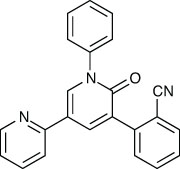
Perampanel
Epilepsy can be difficult to control, and a new medicine from Eisai, perampanel (Fycompa) has been shown to reduce the frequency of seizures. The drug is a non-competitive antagonist of the ionotropic AMPA glutamate receptor on post-synaptic neurons, although the precise mechanism by which it exerts its antiepileptic effect has yet to be fully understood.
Another product to treat a neurological disorder – this time schizophrenia – comes from Alexza. Loxapine (Adasuve) is a typical antipsychotic that is thought to act via agonism of the dopamine D2 receptors and serotonin 5-HT2A receptors. It has calming effects on agitation, and suppresses aggressive behaviour.
Nalmefene (Selencro) from Lundbeck is designed to reduce alcohol consumption in people with alcohol dependency.
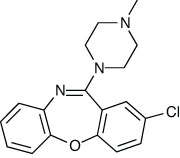
Loxapine
Licensed for use in people with a high drinking risk level but who do not have physical withdrawal symptoms and do not need immediate detoxification, it acts at several opioid receptors, with antagonist activity at the m and d receptors, and partial agonist activity at the k receptor. It is believed to counteract the reinforcement effects of the release of mesolimbic dopamine caused by acute alcohol intake, thus reducing alcohol consumption.
Patients with actinic keratosis develop precancerous small, rough, scaly, crusty patches of skin, generally as a result of sun exposure. A new treatment comes in the form of Leo Pharma’s ingenol mebutate (Picato). The product is an antibiotic and chemotherapeutic that is designed for topical use, and induces local lesion cell death. It also causes an inflammatory response that is characterised by infiltration of immunocompetent cells.
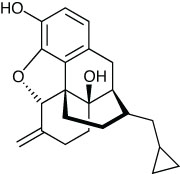
Nalmefene
Finally, another product designed to remove thickened skin, albeit of a very different form. Teva’s NexoBrid is a concentrate of proteolytic enzymes, enriched in bromelain, derived from pineapples, that is designed to remove eschar from burn wounds. Eschar is the thick, leathery necrotic tissue that covers severe burns, which must be removed if the wound is to heal and infections are to be prevented. Normally, this is done surgically; NexoBrid provides a less invasive way of debriding the wounds, and speeds up the healing process.




